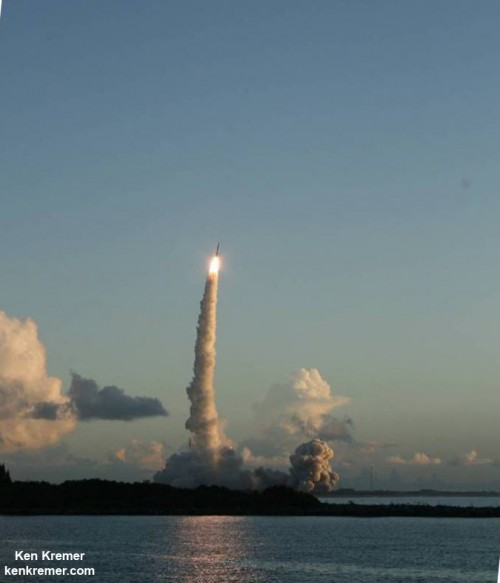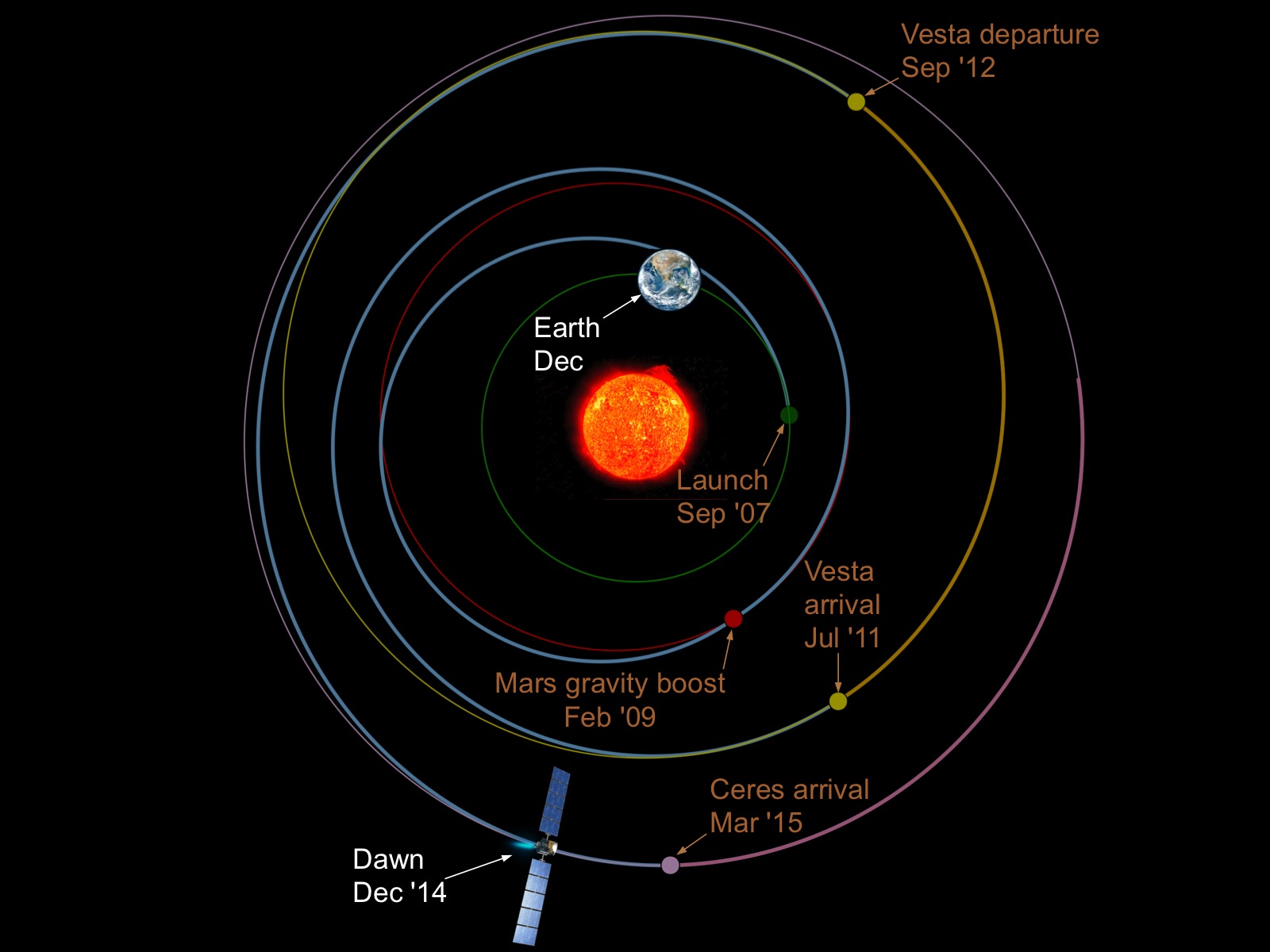
We’ve wondered about Ceres‘ nature and true identity for over two centuries, ever since it was discovered on New Year’s Day, 1801, by Giuseppe Piazzi of Italy. It’s been alternately classified as a planet, asteroid, and more recently as a dwarf planet.
Just gander in amazement at the greatest glimpse yet of the infant world and you’ll quickly realize we are now clearly on the cusp of startling new revelations about the mysteries of Ceres.
And it’s all thanks to NASA’s ion-powered Dawn spacecraft and its revolutionary ion propulsion system now zeroing in on its final approach phase to Ceres for humanity’s first up-close look at the pristine protoplanet.
Today NASA released the most fantastic images yet of the dwarf planet Ceres that were taken just days ago, on Jan. 13, 2014, from a distance of 238,000 miles (383,000 kilometers). That’s about equivalent to the distance from the Earth to the Moon.
The new photos clearly reveal tantalizing hints of craters, ridges, and a rather varied topography with a wide assortment of especially intriguing bright and numerous dark splotches, which we can only guess as to what their true nature and composition may be. Does frozen or liquid water and possibly an alien ecosystem lurk beneath?

And with each passing day, the fuzzy features become ever clearer and clearer as Dawn relentlessly soars closer and closer to her orbital quest. It’s truly mouthwatering!
“We know so much about the solar system and yet so little about dwarf planet Ceres. Now, Dawn is ready to change that,” said Marc Rayman, Dawn’s chief engineer and mission director, based at NASA’s Jet Propulsion Laboratory in Pasadena, Calif.
The new images show the dwarf planet at 27 pixels across, about three times better than the calibration images taken in early December, says NASA, and included in AmericaSpace’s prior Dawn story here.
Besides wowing us with expectations of riches to come, the images will play a key role in navigating Dawn on its final approach to Ceres.
Since the beginning of January, Dawn has trekked closer by some 150,000 miles (230,000 kilometers), or roughly half the distance from the Earth to the Moon.

To date the best views of Ceres have been captured by NASA’s Hubble Space Telescope (HST), using the Advanced Camera for Surveys (ACS) instrument, between December 2003 and January 2004.
“Already, the [latest] images hint at first surface structures such as craters,” said Andreas Nathues, lead investigator for the framing camera team at the Max Planck Institute for Solar System Research, Gottingen, Germany.
“We have identified all of the features seen by Hubble on the side of Ceres we have observed, and there are also suggestions of remarkable structures awaiting us as we move even closer.”
NASA says the new images are about 80 percent of the Hubble resolution and not as sharp. But to this writer’s eye the Jan. 13 images appear sharper.
However you look at it, Dawn’s images will exceed Hubble’s by the end of January. And that’s in just a week and a half!

Ceres is the largest and most massive object in the main Asteroid Belt, which lies between Mars and Jupiter. It measures about the size of Texas, with a diameter of approximately 590 miles (950 kilometers).
Scientists are keenly interested in Ceres as it may harbor an ocean of liquid water as large in volume as the oceans of Earth, below a thick icy mantle, despite its small size—and thus could be a potential abode for life.
But no one knows for sure, and unlocking the secrets to the most fundamental science questions of life and the Solar System’s formation is what Dawn’s objectives are all about.
No spacecraft has ever visited Ceres before.
The solar-powered Dawn is scheduled to arrive in orbit around Ceres on March 6, 2015, for the start of an up-close investigation of a planned 16-month-long mission.
After being captured in orbit, the probe will gradually spiral in over about six weeks to an initial target science orbit of about 8,400 miles (13,500 kilometers), by April 23, 2015.

We really don’t know much about Ceres because unlike Vesta, there are no known meteorites from Ceres.
“The team is very excited to examine the surface of Ceres in never-before-seen detail,” said Chris Russell, principal investigator for the Dawn mission, based at the University of California, Los Angeles. “We look forward to the surprises this mysterious world may bring.”
Dawn is an international science mission collaboration between the U.S., Germany, and Italy, and a project from NASA’s Discovery program.
The ion-powered probe is equipped with three science instruments provided by the three nations to photograph and investigate the surface mineralogy and elemental composition of the gigantic asteroid.
Dawn was launched on Sept. 27, 2007, by a United Launch Alliance (ULA) Delta II Heavy rocket from Space Launch Complex-17B (SLC-17B) at Cape Canaveral Air Force Station, Fla.
It will soon make history as the first spacecraft to orbit two celestial bodies beyond Earth.
After a 3.5-year interplanetary journey, Dawn arrived at the asteroid Vesta, the first of its two orbital targets. Vesta is the second most massive object in the main Asteroid Belt between Mars and Jupiter. The odd-shaped world lacks a south pole and has an average diameter of 326 miles (525 kilometers).
During a 14-month-long survey, starting in July 2011, the spacecraft snapped over 30,000 images and collected reams of spectra revealing many new insights about Vesta until September 2012—when it broke out of orbit and began the long trek to Ceres as the blue light special.
Stay tuned here for continuing updates!
– Want to keep up-to-date with all things space? Be sure to “Like” AmericaSpace on Facebook and follow us on Twitter: @AmericaSpace





what will happen to dawn after the ceres encounter? will it stay in orbit forever or crashed onto ceres surface?
We are experiencing an explosion of planetary discoveries. The information gleaned from Ceres and Pluto will give mankind a better understanding of the outer regions of our Solar System. It is with great anticipation to see the images of both objects. Wow! I would like to know what that “white spot” might be near the northern region of Ceres. Ken, another outstanding post!
Clearly the white spot is a dome city that past earth civilizations relocated to during times of Global Climate Change….Or its just clouds or Ice…can’t wait to see!
Thanks! Tom and Tracy we’ll find out soon about the white spot ID!
So, this multi-million-dollar space craft is as close to its target a the Earth is to the moon, and yet we can’t even get images equivalent in quality to 1x resolution? Is Vesta armed with a cell phone camera? Certainly the naked eye could discern better detail than this at such a distance.